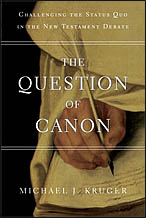Review by Dr. Jon Pratt
With this most recent addition to his list of books on the NT canon (see Canon Revisited [Crossway, 2012] and The Heresy of Orthodoxy [Crossway, 2012] coauthored with Andreas Köstenberger), Michael Kruger, professor of NT at Reformed Theological Seminary in Charlotte, NC, provides a helpful resource for those committed to the intrinsic model of canon development. What is the intrinsic model? It is the idea that the NT canon came to include the 27 books by virtue of the internal qualities of the books themselves rather than by imposition of the will of certain church or governmental leaders from outside the biblical literature itself. In contrast, the notion that the formation of the NT canon is a late, ecclesiastical or political activity which was imposed on the writings is referred to as the extrinsic model of canon development. And this extrinsic model has come to be the dominant view in modern biblical studies.
Kruger believes that the intrinsic model is the better of these two approaches to canon development, but his goal in this book is not to prove the intrinsic model as much as it is to debunk the five major tenets used in support of the extrinsic model. Here are the five tenets: 1) we must make a sharp distinction between Scripture and canon; 2) there was nothing in earliest Christianity that would have led to a canon; 3) early Christians were averse to written documents; 4) the NT authors were unaware of their own authority; and 5) the NT books were first regarded as Scripture at the end of the second century during the time of Irenaeus. Each of the five chapters of the book is dedicated to one of these major tenets.
Kruger writes with a clear and straightforward style, and he follows the same basic method of argumentation in each of the chapters as he responds to the particular tenet in view. First, he provides ample evidence that the tenet is not a straw man he is preparing to destroy. Rather, he quotes significant scholars and summarizes their views with fairness. Next, he proceeds by various means to debunk the tenet in question. He may provide a series of arguments which directly contradict the dogma (see chapters 2, 4, and 5); he may summarize the supporting propositions of the tenet and then categorically dismantle each one (see chapter 3); or he may demonstrate that the issue at hand should not be viewed as an either-or proposition (as in the case of the definition of canon in chapter 1) but as a both-and situation. Finally, he provides a conclusion that helpfully summarizes the case he has made against the tenet.
Since there is a great dearth of well-argued books on the NT canon in orthodox Protestantism (H. N. Ridderbos’ The Authority of the New Testament Scriptures [Presbyterian & Reformed, 1963] and R. Laird Harris’ Inspiration and Canonicity of the Bible [Zondervan, 1957] are the best before now), Kruger’s contribution, along with his other works on this subject, provides much hope for the future of canon studies. While many books and articles have been written in recent years supporting the extrinsic model of canon production (read this book to see an abundance of evidence for this statement) as well as other secular theories with regard to the makeup of the NT, conservative Christians need what Michael Kruger is writing about. Thankfully, his writing is cogent, concise, well-documented, and even-handed. Therefore, I found little with which to disagree and much for which to be thankful.
While this topic may prove to be a bit technical for the uninitiated, Kruger’s writing style helps to explain some of the complex nuances of canon studies so that the typical lay person can grasp the arguments quite readily. Particularly valuable is his chapter on the definition of canon (Chapter 1). This chapter alone makes the purchase of this volume worth the investment. Here Kruger shows that the issue of definition does not need to be isolated to one particular view in distinction from others. (Incidentally, this chapter helps to dispel a consistent trend in academic studies—dichotomization, the notion that one’s view of something must be seen in opposition to other perspectives.) Instead, he shows that the definition of canon should be integrative and multidimensional in its explanation. Thus, the exclusive, functional, and ontological definitions of canon all help to provide a “much-needed clarification to the ongoing debate over the [meaning] of canon” (p 43).
Though Michael Kruger’s purpose is not ultimately to defend the intrinsic model, his arguments against the five tenets of the extrinsic model actually help to do this. And this is why The Question of Canon is worth reading. Pastors and professors will benefit from the arguments presented here, and they ought to own it. Informed congregants will be armed with several helpful arguments, attacking the presuppositions of the extrinsic model on the one hand while also supporting many aspects of the intrinsic model on the other.
Dr. Jon Pratt is VP of Academics and Professor of New Testament at Central Seminary in Minneapolis.
